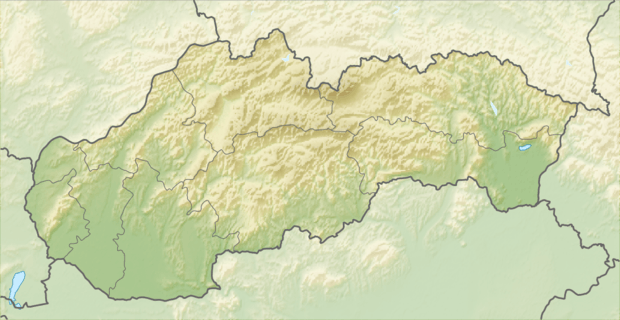Malé Dvorníky
Malé Dvorníky (Hungarian: Kisudvarnok, Hungarian pronunciation:[ˈkiʃudvɒrnok]) is a village and municipality in the Dunajská Streda District in the Trnava Region of south-west Slovakia.
Malé Dvorníky Kisudvarnok | |
|---|---|
village | |
 Location of the village | |
| Coordinates: 48°00′40″N 17°38′35″E | |
| Country | |
| Region | Trnava |
| District | Dunajská Streda |
| First written mention | 1336 |
| Government | |
| • Mayor | Zoltán Marcell (Most-Híd) |
| Area | |
| • Total | 6.885 km2 (2.658 sq mi) |
| Elevation | 115 m (377 ft) |
| Population (2001)[3] | |
| • Total | 1,126 |
| • Estimate (2008) | 1,036 |
| • Density | 150/km2 (400/sq mi) |
| Ethnicity | |
| • Hungarians | 92,51 % |
| • Slovaks | 7,16 % |
| Time zone | UTC+1 (EET) |
| • Summer (DST) | UTC+2 (EEST) |
| Postal Code | 929 01 |
| Area code(s) | +421 31 |
| Website | www |
Geography
The municipality lies at an altitude of 115 metres and covers an area of 6.885 km².
History
In the 9th century, the territory of Malé Dvorníky became part of the Kingdom of Hungary. It was an Avar settlement in the 6th century. The name of the village was first recorded in 1254 as "Odour". Until the end of World War I, it was part of Hungary and fell within the Dunaszerdahely district of Pozsony County. After the Austro-Hungarian army disintegrated in November 1918, Czechoslovak troops occupied the area. After the Treaty of Trianon of 1920, the village became officially part of Czechoslovakia. In November 1938, the First Vienna Award granted the area to Hungary and it was held by Hungary until 1945. After Soviet occupation in 1945, Czechoslovak administration returned and the village became officially part of Czechoslovakia in 1947. In 1946, a great number of local Hungarian families were deported to the Czech lands, but most of them were able to return later.
Demography
In 1910, the village had 445, for the most part, Hungarian inhabitants. At the 2001 Census the recorded population of the village was 894 while an end-2008 estimate by the Statistical Office had the villages's population as 1036. As of 2001, 92,51 per cent of its population was Hungarian while 7,16 per cent was Slovak.
Roman Catholicism is the majority religion of the village, its adherents numbering 87.58% of the total population.[3]
References
- Local election results by the Statistical Office of the Slovak Republic, December 2006 Archived 2012-03-08 at the Wayback Machine
- Local election 2010 results by the Statistical Office of the Slovak Republic Archived 2011-08-11 at the Wayback Machine
- "Urban and Municipal Statistics MOŠ". Archived from the original on 2011-02-26.